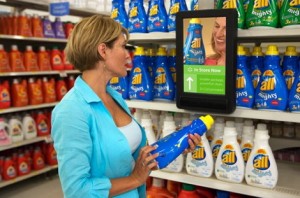Dylan Jones, Jones Digital Media
At this year’s National Retail Federation conference, Walmart unveiled a few titillating numbers for their self-congratulatory named, Walmart Smart Network.
Presenting with their media and content partner, Studio Squared (which is essentially a chimera of Walmart, The Martin Agency and Media Vest) they unveiled some compelling sales lift numbers for their end-cap program.
According to marketing director and Smart Network general manager James Beck, the company’s online media program delivers 1 billion ad impressions per month to an audience of 32 million monthly unique visitors – visitors spend an average of 15 minutes on the site each visit.
Allegedly when that program is COUPLED with the Smart Network the digital media program has a monthly reach of between one-third and one-half of the U.S. population.
Bill McMullen, general manager of Studio Squared who works with suppliers to develop campaigns for the Walmart digital media program shared a couple of specific case studies..
- a breathing-strip manufacturer purchased an endcap campaign, in which a 90- to 120-second message ran on endcap screens with product positioned around it. While the program was running, the brand saw a 100 percent sales lift on the specific product, determined by testing versus a control group
- the retailer wanted to increase the number of shoppers that opted in to receive discounts and offers via SMS. It staged a four-week campaign in which shoppers were told that if they’d sign up by dialing a specific code, they’d get exclusive announcements of new “Rollback” offers. During the four-week period, the retailer saw a three-fold increase in daily opt-ins
Not surprisingly, the sales lift numbers are pretty impressive and it’s compelling stuff BUT I’m asking myself a few questions about the relevance of these numbers when it comes to the overall Smart Network.
I don’t think it takes a rocket scientist to figure out that if you put a compelling enough commercial on a screen next to that product, you’re going to lift sales.
The question is, how is the rest of the network performing. How are the vertical screens in food and grocery lifting sales? What about screens at checkout? What about the much lauded ‘Welcome Screen‘ at the entrance (a kind of digital greeter without the drawl) How are they measuring those, other than with viewership numbers?
There are a few realities about “end-cap tv” that should be pointed out. Walmart stocks millions of products and launches hundreds of new products on the shelf every week, and if you’re lucky enough to be chosen for an end-cap program, then you’ll also find yourself with a healthy sales lift number!
The reality is you can’t of course give every product in the store an end-cap display, so how are all those other ads performing? Brands are spending money all over the Smart Network, I’d like to know what the RIO is on those other screens.
I’m glad Walmart are sharing these numbers, but right now it’s like McDonald’s touting the healthfulness of their salads when we all know it’s all about the Big Mac.


January 17th, 2011 at 14:11 @633
There is no question that end-cap video will improve the already powerful “almost impulse” purchase appeal of traditional stocking arrangements.
That being said, if the Walmart Network is not as aggressive in developing the value of the entire network system, then they are likely short changing their marketers and certainly themselves. In fact, it is not uncommon for television network buys to require a marketer to purchase spots in a series of shows and not just the big prime time hits. It would be surprising if Walmart’s team is not mixing a number of end-cap buys with full network–or at least department–buys as part of the package.
In the early days of this network, many agency decision-makers were not supporters of the ability to reach and influence viewers (shoppers) in that last 30-seconds of brand relevance. The “to buy or not to buy” question as the result of in-store video advertising just did not register with many traditional media decision-makers at that time–coupons were the exception. It took P&G, Unilever, Energizer, Kodak, Nabisco and many other thoughtful marketers in early 90’s to take the lead in this obvious new media platform. Their leadership was crucial in paving the way for today’s success in the power of video advertising delivered when/where the viewer is actually a shopper to generate solid equity and promotional outcomes.
Walmart (Lee Scott, then EVP, signed the first contract) deserves the credit for seeing this vision as far back as 1992 with its involvement in the early executions setting the stage for this network. Today, this WM/PRN early vision provides the retailer an uncommon competitive opportunity to communicate with its customers in the multi-screen world. This should make it easier for the current team to leverage fixed and mobile screen campaigns compared to its competition.
WM leadership is clear since Target and Best Buy have been playing catch-up with their own managed in-store/online/mobile network integrations over the past couple of years.
Interesting bit of category history is that Safeway and PRN built its first integrated end-cap screen, coupon, and shelf-stocking in-store execution with an 80 store pilot in the Phoenix market in 1995/96.
Guess what? It worked then and it works now. It was just too expensive in those days to expand into the 1,000-store universe offered at the end of the pilot. The pilot featured 80 brand participants with matched panel results reporting 19% to 100% sales lifts.
The more things change…